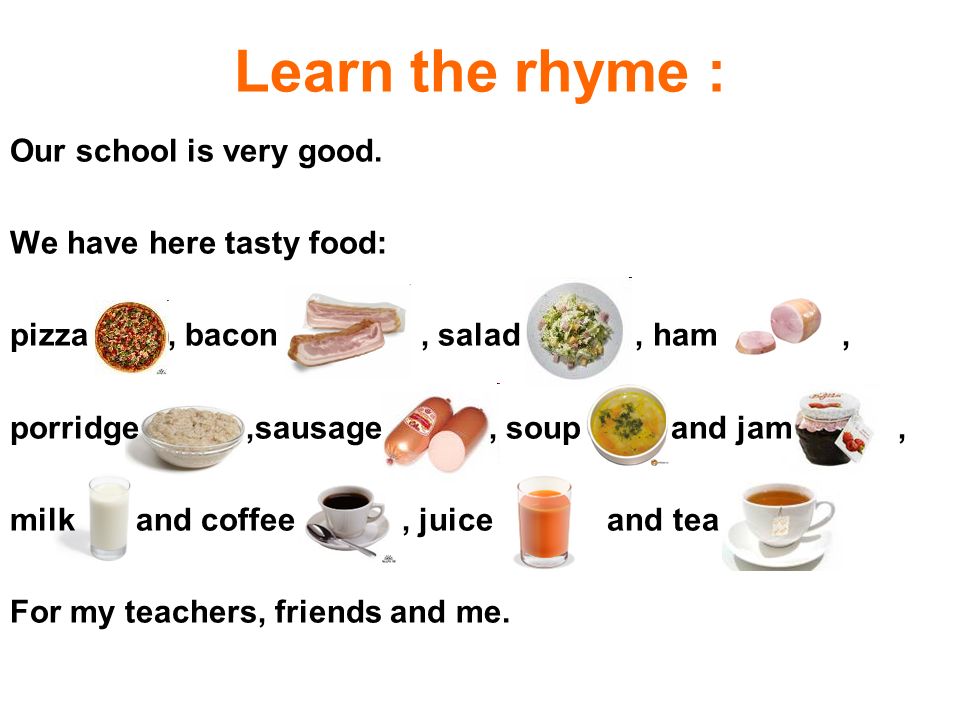What and how much to feed a 6 month baby
Feeding your baby: 6–12 months
At 6 months of age, breastmilk continues to be a vital source of nutrition; but it’s not enough by itself. You need to now introduce your baby to solid food, in addition to breastmilk, to keep up with her growing needs.
Be sure you give your baby her first foods after she has breastfed, or between nursing sessions, so that your baby continues to breastfeed as much as possible.
When you start to feed your baby solid food, take extra care that she doesn’t become sick. As she crawls about and explores, germs can spread from her hands to her mouth. Protect your baby from getting sick by washing your and her hands with soap before preparing food and before every feeding.
Your baby's first foods
When your baby is 6 months old, she is just learning to chew. Her first foods need to be soft so they’re very easy to swallow, such as porridge or well mashed fruits and vegetables. Did you know that when porridge is too watery, it doesn't have as many nutrients? To make it more nutritious, cook it until it’s thick enough not to run off the spoon.
Feed your baby when you see her give signs that she's hungry – such as putting her hands to her mouth. After washing hands, start by giving your baby just two to three spoonfuls of soft food, twice a day. At this age, her stomach is small so she can only eat small amounts at each meal.
The taste of a new food may surprise your baby. Give her time to get used to these new foods and flavours. Be patient and don’t force your baby to eat. Watch for signs that she is full and stop feeding her then.
As your baby grows, her stomach also grows and she can eat more food with each meal.
Feeding your baby: 6–8 months old
From 6–8 months old, feed your baby half a cup of soft food two to three times a day. Your baby can eat anything except honey, which she shouldn't eat until she is a year old. You can start to add a healthy snack, like mashed fruit, between meals. As your baby gets increasing amounts of solid foods, she should continue to get the same amount of breastmilk.
Feeding your baby: 9–11 months old
From 9–11 months old, your baby can take half a cup of food three to four times a day, plus a healthy snack. Now you can start to chop up soft food into small pieces instead of mashing it. Your baby may even start to eat food herself with her fingers. Continue to breastfeed whenever your baby is hungry.
Each meal needs to be both easy for your baby to eat and packed with nutrition. Make every bite count.
Foods need to be rich in energy and nutrients. In addition to grains and potatoes, be sure your baby has vegetables and fruits, legumes and seeds, a little energy-rich oil or fat, and – especially – animal foods (dairy, eggs, meat, fish and poultry) every day. Eating a variety of foods every day gives your baby the best chance of getting all the nutrients he needs.
If your baby refuses a new food or spits it out, don’t force it. Try again a few days later. You can also try mixing it with another food that your baby likes or squeezing a little breastmilk on top.
Feeding non-breastfed babies
If you're not breastfeeding your baby, she’ll need to eat more often. She'll also need to rely on other foods, including milk products, to get all the nutrition her body needs.
- Start to give your baby solid foods at 6 months of age, just as a breastfed baby would need. Begin with two to three spoonfuls of soft and mashed food four times a day, which will give her the nutrients she needs without breastmilk.
- From 6–8 months old, she’ll need half a cup of soft food four times a day, plus a healthy snack.
- From 9–11 months old, she’ll need half a cup of food four to five times a day, plus two healthy snacks.
Food for 6-Month-Old Babies: A Detailed Overview
What should 6-month-olds eat?
This is a pivotal stage in your baby’s development. Your bundle of joy is willing to try all kinds of things right now, so offer them a wide range of flavors and textures. Taste-wise, it’s usually best to work your way from bland to sweeter or saltier.
Just remember to be wary of possible allergies. New items should be introduced individually, and at least a week apart, so you can clearly identify what they can or can’t handle. Also, steer clear of unhealthy foods with little or no nutritional value.
A 6-month-old baby’s diet will center on the following:
- Breast milk and/or formula:
It remains their primary source of nutrition and sustenance. Even after adding solid foods to your child’s menu, you should still provide them with plenty of breast milk or formula at each feeding. (It’s important to note, however, that research has shown breast milk may help prevent childhood obesity. Formula consumption affects the makeup of microbes in your baby’s growing gut. These microbes heavily influence the way their body digests food and draws energy from it.)
- Solid foods:
Are you convinced that they’re ready to make the transition to solids? Signs of readiness include better hand-to-mouth coordination, decreased tongue protrusion reflex, sitting up unassisted, and opening their mouth for the spoon. Simply keep in mind that this process requires plenty of patience, preparation, and timing.
Simply keep in mind that this process requires plenty of patience, preparation, and timing.
Tips for introducing solid foods
This is a major stepping stone for your 6-month-old as it lays the foundation for lifelong eating habits. It also helps determine how willing they’ll be to explore new flavors and textures down the road. Below is a list of healthy options for baby’s first solids.
- Oatmeal or brown rice cereal
- Pureed meats like chicken, pork, or beef
- Pureed or strained fruits like bananas, pears, peaches, or avocados
- Pureed or strained vegetables like carrots, squash, or sweet potatoes
Lastly, stay away from potential choking hazards such as small fruits, raw vegetables, nuts, candy, gum, and whole grapes.
It may take a while for your child to become accustomed to eating solid foods. Before tackling this challenge, you should take the following factors into account.
- Timing:
Since every 6-month-old is unique, there is no perfect time for switching to solids. While you’re still nursing, consider introducing them whenever your milk supply is low.
While you’re still nursing, consider introducing them whenever your milk supply is low.
- Mood:
Your little one’s mood can speak volumes. If they wake up cheerful and energetic, they might be more open to trying something new. However, if they appear cranky and sleepy, then breast milk or formula is your safest bet.
- Patience:
Getting even one tiny spoonful into their mouth is often a huge task. That’s why it’s critical to give yourself and your 6-month-old plenty of time for feedings. Meals will go more smoothly when time and patience aren’t in short supply.
- Preparation:
A silicone or plastic spoon is the gentlest choice for your child’s tender gums. Keep three spoons handy: one for you, one for them, and a spare to replace the one that’ll inevitably wind up on the floor. Now is also a prime opportunity to get them in the habit of wearing a bib at mealtime.
- Pacing:
Solid foods can be a bit of a shock when you’re used to milky, liquid textures. Start slowly and put about a quarter teaspoon of food on the tip of your baby’s tongue. If they swallow it, place the next quarter teaspoonful a little farther back on their tongue.
Start slowly and put about a quarter teaspoon of food on the tip of your baby’s tongue. If they swallow it, place the next quarter teaspoonful a little farther back on their tongue.
How much should 6-month-olds eat?
You have to walk a very fine line between overfeeding your little one and leaving them hungry for more. The amount they should be consuming varies based on what they’re eating or drinking.
- Breast milk: Generally speaking, you’ll need to nurse your baby five to six times in a 24-hour period; although some children require more. They’ll consume between 24 and 36 ounces per day.
- Formula: On average, your child will have to be bottle-fed four to five times in a 24-hour period. This breaks down to roughly 6 to 8 ounces of formula per serving, for a daily total of 24 to 32 ounces.
- Solid foods: If your 6-month-old is exploring solids now, start with very small quantities. Begin with just an ounce of baby food and gradually increase to 3 ounces.
 If they enjoy it, offer 1 tablespoon of cereal mixed with breast milk or formula (or fruits and veggies) three times a day. Remember to proceed slowly and pay attention to their cues.
If they enjoy it, offer 1 tablespoon of cereal mixed with breast milk or formula (or fruits and veggies) three times a day. Remember to proceed slowly and pay attention to their cues.
How often should 6-month-olds eat?
A good rule of thumb is to start feeding at the earliest sign of hunger, and stop feeding at the earliest sign of fullness. Feeding schedules, however, are determined by whether your child is breastfed or formula-fed.
- Formula-fed babies: Provide 6 to 8 ounces of formula per serving, six times a day. You may wish to supplement with 1 to 3 ounces of solid food, three times a day.
- Breastfed babies: Nurse your 6-month-old every three to four hours daily. Similarly, you can supplement with 1 to 3 ounces of solid food, three times a day.
This is an especially exciting time for you and your baby. Although you’ll continue offering their most essential nutrition in the form of breast milk and/or formula, you’re also broadening their horizons.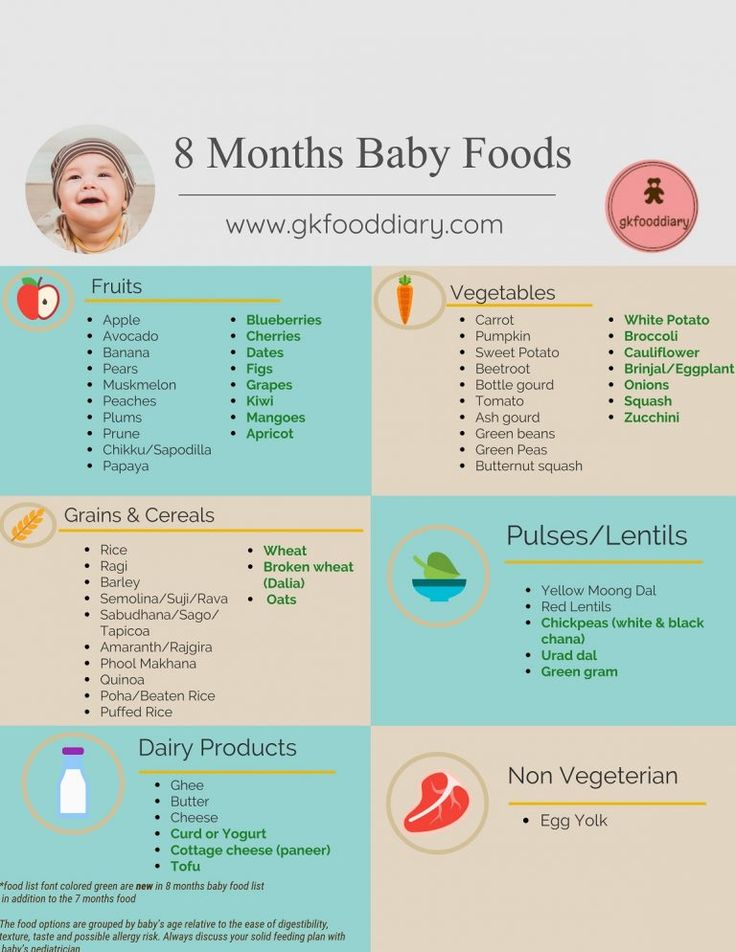 Be sure to follow your 6-month-old’s cues and gradually incorporate new flavors and textures into their diet.
Be sure to follow your 6-month-old’s cues and gradually incorporate new flavors and textures into their diet.
diet, daily routine, how to introduce complementary foods
We publish the menu of a child at 6 months, recommended by the Institute of Nutrition of the Russian Academy of Medical Sciences. Please note that these are only examples of how children at this age can eat. The volume and timing of the introduction of complementary foods for a particular child are determined individually by a pediatrician.
When to introduce complementary foods for a breastfed baby
WHO recommends exclusive breastfeeding for 6 months. If:
The baby was born full term and healthy with normal body weight.
The child has no delay in physical development and malnutrition.
The mother eats fully, her daily menu contains specialized enriched foods or vitamin-mineral complexes.
At 6 months, the first complementary foods are introduced.
According to the doctor's decision, made on the basis of the individual characteristics of the child's development, complementary foods can be prescribed earlier, but not earlier than 4 months.
The age of introduction of complementary foods is associated with indicators of the functional and physical development of the child:
The initially high permeability of the mucous membrane of the small intestine decreases.
The production of digestive enzymes is stabilized.
Sufficient local immunity is formed in the digestive tract.
The child learns to swallow semi-liquid and thicker foods.
According to local pediatricians, it is also not worth delaying the introduction of complementary foods after 6 months. If you do not add new foods to the diet, you may develop a deficiency of important nutrients - including iron, zinc, and others.
Important!
The timing of the introduction of complementary foods is determined by the pediatrician individually for each, taking into account age, characteristics of the prenatal period and childbirth, weight and pace of physical development, the presence of diseases and other factors.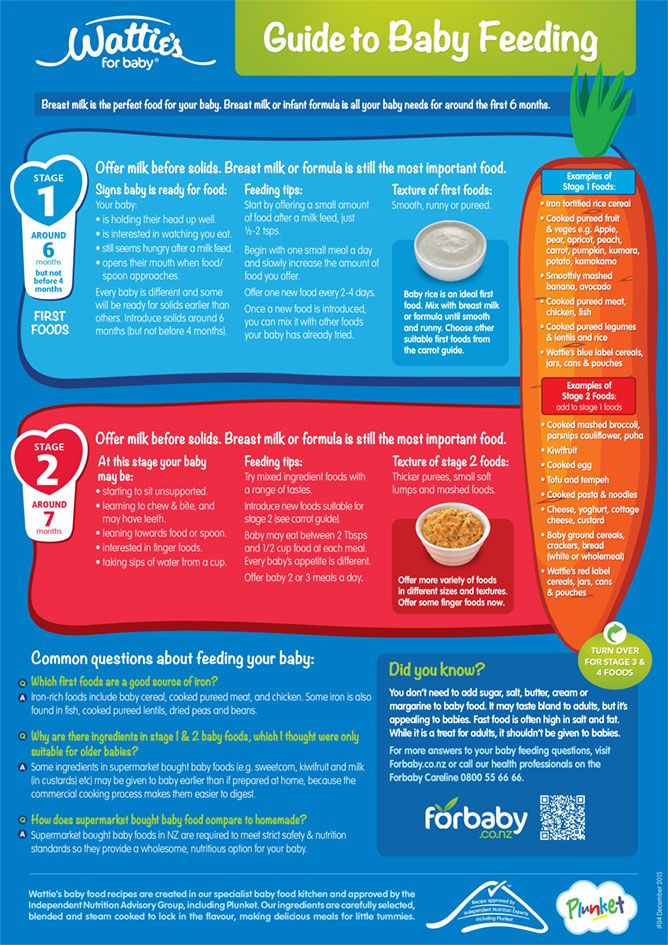
General rules for introducing complementary foods while breastfeeding
It is best to discuss the introduction of complementary foods with your pediatrician. The doctor will tell you when you can introduce complementary foods, what foods to start with and what aspects you should pay attention to.
When drawing up a sample menu for a child's nutrition together with a doctor, the following important points should be taken into account:
Children with insufficient weight and frequent stools are recommended to give cereals enriched with iron, zinc, calcium and iodine as the first complementary food.
Children with overweight and constipation - vegetable puree.
Proven!
In order for the baby to accept a new dish, he must try it repeatedly - up to 12-15 times. Do not be afraid of refusal, offer the product again, try complementary foods in his presence - and the baby will definitely become interested in new food.
Sample menu for a 6-month-old baby per day
Select complementary foods
At 6 months, the baby should eat 5 times a day. Complementary foods are introduced only for daytime feedings - for breakfast, lunch and dinner. Mother's milk remains for the first and last feeding.
Complementary foods are introduced only for daytime feedings - for breakfast, lunch and dinner. Mother's milk remains for the first and last feeding.
Asking what to feed a child, parents ask: is it necessary to breastfeed along with complementary foods? Pediatricians believe: in the daily menu for an aged baby, mother's milk should be mandatory at every feeding. The volume will depend on how much complementary foods have already been introduced.
Let's see how to calculate this using an example.
Baby at 6 months should receive 200 g of food per feeding. If he ate 60 g of vegetable puree, he should receive another 140 ml of mother's milk or baby milk.
Important!
Breast milk offered after complementary foods!
Sample menu for a 6 month old baby for a week
The menu should include a variety of products. They should be introduced gradually. The kid begins to get acquainted with new dishes with a minimum portion. For example, it can be a teaspoon (5 g) of vegetable or meat puree or 2 teaspoons (10 g) of porridge.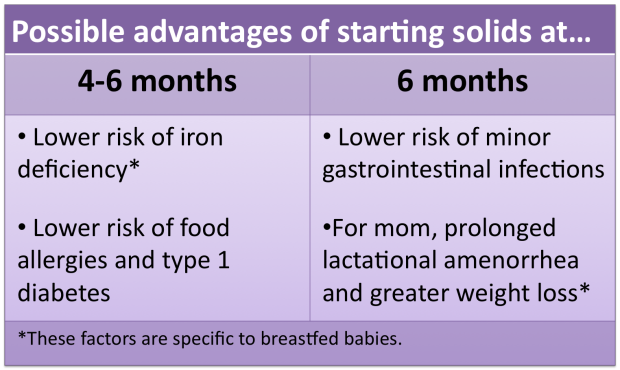
The approximate amount of food for a baby at 6 months is indicated in the table (according to the recommendations of the Union of Pediatricians of Russia).
Name of products and dishes (g, ml)
Age (month)
7
8
9-12
Vegetable puree
170
180 9000 9000 180
200
Fruit puree
70
80
90-100
Fruit juice
70
80
90-100
Curd*
40
40
50
0.25
0.5
0.5
Puree
30
50
60-70
Puree
-
5-30
30-60
kefir and other non-adapted fermented milk drinks
-
200
200
Rusks, biscuits
3-5
5
10-15
Wheat bread
Vegetable oil
Butter
* - not earlier than 6 months.
An approximate menu for a child for a week at 6 months is presented in the table. Please note: this is only a guide for parents - to know how a child can eat at this age. More detailed and accurate recommendations will be given by the pediatrician observing your baby.
More detailed and accurate recommendations will be given by the pediatrician observing your baby.
Monday
06:00
breast milk
200 ml
10:00
Nestlé® porridge “Silent rice hypoallergenic”
100-150 g
Breast milk (donkey)
9000 14:00
Meat pure ® Indiana
20 g
Gerber® vegetable “only color cabbage”
100-150 g
Breast milk (donkey)
18:00
Fruous puree Gerber® “ Only an apple"
60 g
Breast milk (donkey)
22:00
Breast milk
200 ml
Tuesday
06:00 9000
Nestlé® Milk buckwheat
100-150 g
Fruit juice GERBER® “Apple Prossidized”
60 ml
breast milk (donkey)
14:00 9Ol000 Gerber® Persik Pue
60 g
breast milk (top feed)
22:00
Breast milk
200 ml
Wednesday
06:00
Breast milk
200 ml
10:00
Gerber® Kultislakaya with Apple and Bunny "
100-150 g
Fruit juice Gerber®" Apple-breast-breast "
60 ml
Breast milk. (donkey)
(donkey)
14:00 9000
18:00 9000 06:00
Breast milk
200 ml
10:00
Nestlé® Silent corn
100-150 g
Fruit juice Gerber® “Grozhevy”
9000 ml
Breast milk (complementary feeding)
14:00
Maucure Gerber® "Indeka"
20 g
Gerber® vegetable puree for the first feeding 9000,100-150 g 9000 g
9000
Breast milk (complementary feed)
18:00
002 breast milk
200 ml
Friday
06:00
Breast milk
200 ml
10:00
Nestlé® Milk oatmeal
9000 g9000
fruit juice gerber gerber gerber gerber ® “Apple Courage”
60 ml
Breast milk (donkey)
14:00
Gerber® Made Puree
9000 20 g
Gerber® vegetable only carrots only
100-150 g
Breast milk (donkey)
18:00
Gerber® fruit puree
60 g
Breast milk (suicide)
22 22 22 22 22 22 22 22 22 22 22 : 00
Breast milk
200 ml
Saturday
06:00
Breast milk
200 ml
10:00
002
Breast milk (complementary feed)
14:00
Maucure Gerber® “Indika”
20 g
Gerber® Pureta “only Color cabbage”
9000 100-150 g
9000
Breast milk (donkey)
18:00
003
200 ml
Sunday
06:00
Breast milk
200 ml
10:00
Breast milk (leopard)
14:00
Puree Gerber® Puree
20 g
Gerber® vegetable Broccoli only
100-150 g
Breast milk (completeness)
18:00
Gerber® Fruit Persik
60 g
Breast milk (supplementary)
22:00
Breast milk
200 ml
Here is the menu for a breastfed baby.
Important!
To maintain lactation, during the introduction of complementary foods, you need to put the baby to the breast after each feeding! According to WHO recommendations, it is worth continuing to feed the baby with breast milk even after the appearance of new products in his diet.
- 1. National program for optimizing the feeding of children in the first year of life in the Russian Federation. Union of Pediatricians of Russia. Moscow 2019.
- 2. Feeding and nutrition of infants and young children. Guidelines for the WHO European Region with a special focus on the republics of the former Soviet Union.
- 3. www.who.int/features/factfiles/breastfeeding/en
- 4. Safina, A.I. Modern approaches to the nutrition of children from one to three years old / A.I. Safina // Bulletin of modern clinical medicine. - 2016. - Vol. 9, no. 2. - P. 77-85.
- Obstetrician-gynecologist (Southern State Medical University, Faculty of Pediatrics, specialization at the Department of Obstetrics and Gynecology)
Others articles by the author
diet for a 6-month-old baby with breast and artificial feeding, an approximate menu for a week in the table, a diet for a day
Published: 02/10/2021
Reading time: 4 min.
Number of reads: 227789
Author of the article: Ponomareva Yuliya Vladimirovna
Pediatrician, Candidate of Medical Sciences, Allergist-Immunologist
Changes in a child in the first year of life are very rapid, and every month is not like another. The 6-month milestone is very important, it is largely evaluative and transitional. By this age, most babies have doubled their birth weight, are about 15 cm tall, and some babies have already erupted their teeth. The age of 6 months is also transitional in terms of nutrition. Breast milk or an adapted formula is still the basis of the diet, but with the beginning of the second half of life, all children, without exception, should begin to receive complementary foods. Despite the general graph of growth and weight gain and indicators of psychomotor development, the status and diet of children at 6 months can be very different.
Content: Hide
- The first feeding of 6 months
- The beginning of complementary foods at 4-5 months
- The second half of life
- The approximate menu for a week for a child at 6 months
The first feeding of 6 months
9000 9000 9000 9000 9000 9000 9000 9000 9000 9000 9000 9000 9000 9000 9000 If the baby is healthy and breastfed, and his mother eats a full and varied diet, exclusive breastfeeding is possible until this age. Cereal complementary foods in this case are preferable to start. This is due to the high energy and nutritional value of cereals, the ability to significantly enrich the baby's diet with a delayed start of the introduction of complementary foods.
Cereal complementary foods in this case are preferable to start. This is due to the high energy and nutritional value of cereals, the ability to significantly enrich the baby's diet with a delayed start of the introduction of complementary foods.
However, the rate of expansion of the child's diet in this situation will be accelerated. Before the 8th month of life, it is necessary to introduce all basic food groups into the baby’s menu, since in the second half of the year the need for additional intake of nutrients and micronutrients is very high. Another reason explaining the importance of the rapid introduction of complementary foods is the formation of immunity of the immune cells of the intestine to ordinary food. If a child is introduced to these foods at the age of 4-8 months, the risk of developing food allergies has been proven to be reduced.
Complementary feeding starts at 4-5 months
In modern life, the nutrition of a nursing mother, unfortunately, is not always complete.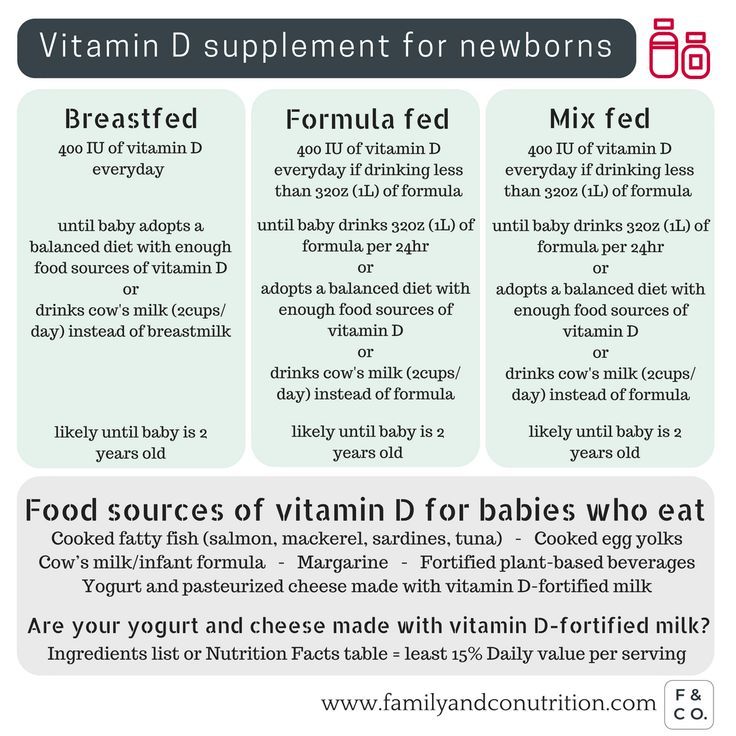 Therefore, for most breastfed babies, complementary foods already need to be introduced from 5 months in order to prevent deficient conditions.
Therefore, for most breastfed babies, complementary foods already need to be introduced from 5 months in order to prevent deficient conditions.
If a child is bottle-fed, then by the 4th month of life, the baby will not have enough adapted formula alone, and in this group of children, the timing of the introduction of complementary foods usually shifts a month earlier than in breast-fed babies. Accordingly, by 6 months, children will have vegetable puree and gluten-free porridge (buckwheat, corn and rice) in their diet. In the first half of life, monocomponent meals are used (that is, from one type of grain and vegetables), prepared on the basis of water, breast milk or an adapted mixture.
Fruit puree and juice can be another possible complementary food for children under 6 months of age without allergy symptoms. In a child with a risk of developing or manifesting allergies, the timing of the introduction of fruit complementary foods is shifted to the 8th month.
Second six months of life
Children over 6 months of age can supplement their diet with cereals containing gluten.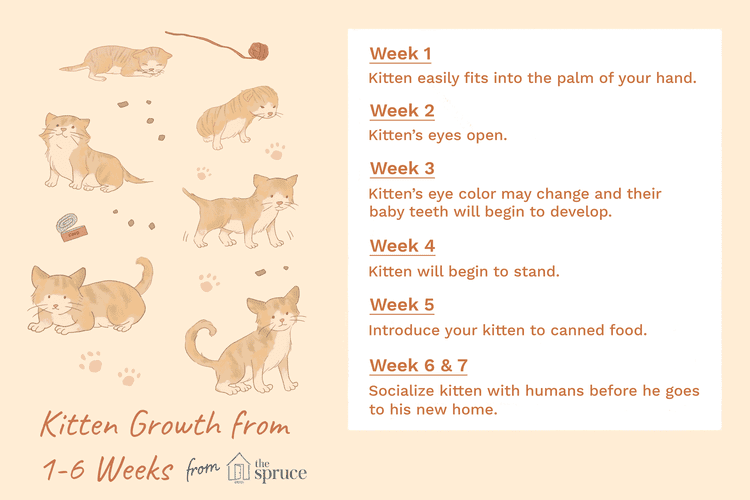 First of all, these are oatmeal and wheat porridge, and then multi-cereal dishes with the addition of other cereals (millet, barley, rye). If the child does not have any manifestations of allergies, milk porridge can be included in the menu at this age. Bebi Premium industrial baby food products include specially prepared milk that is safe to use in healthy babies in the first year of life.
First of all, these are oatmeal and wheat porridge, and then multi-cereal dishes with the addition of other cereals (millet, barley, rye). If the child does not have any manifestations of allergies, milk porridge can be included in the menu at this age. Bebi Premium industrial baby food products include specially prepared milk that is safe to use in healthy babies in the first year of life.
From the age of 6 months, the baby's diet is expanded with such important products as meat and cottage cheese. These products are a source of high-quality protein, fats, and are also rich in minerals such as iron, calcium, and phosphorus. Pediatricians and nutritionists recommend introducing meat and cottage cheese as part of combined dishes based on a fruit and vegetable and / or grain component in a ratio of 1 (cottage cheese / meat): 4–5 (fruits / vegetables / cereals).
To enrich the diet with polyunsaturated fatty acids in the second half of the year, the menu includes vegetable oil in the amount of 3–5 grams per day, which can be added to the complementary food dish.










